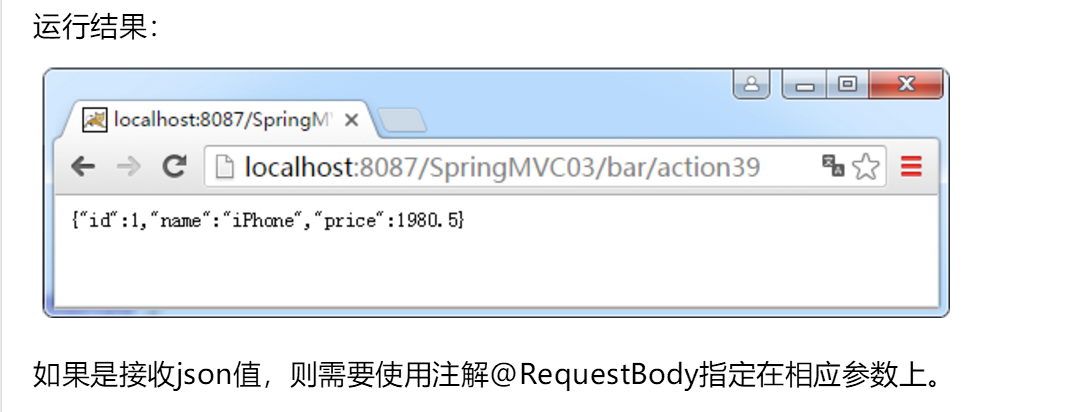内容参考自博客:
http://blog.csdn.net/u011001084/article/details/52846791
http://blog.csdn.net/xuxiaoyinliu/article/details/50349011
https://www.cnblogs.com/best/p/5669010.html#_lab2_1_0
Controller接收的参数:
基本数据类型像int,spring是可以直接转换的方法,当参数名与http中请求的参数名称相同时会进行自动映射。
String也是一样的。
然后是非String的引用型,像Integer,传个3过来Spring也是会转换的。
当参数为实体类的时候,像
@RequestMapping("xxx")public String sent(Book s) (Book有String bookName float price 两个属性)
这种情况服务器会将Book类实例化(所以如果没有@RequestParam(required=false)实体引用类参数在服务器端得到的结果不可能为null),在该类中找到其set方法所对应的所有属性,如果地址中有对应的属性就会对其赋值,反之采用默认值,这时参数相当于
@RequestMapping("xxx")public String sent(String bookName, Float price)
甚至可以是复杂数据类型,就是指一个自定义的类里面还有其他的对象类型。具体的自己尝试。
还可以是List,但不能直接在action中指定List<T>类型,要定义一个类把list集合包装在其中。看个例子:
package com.zhangguo.springmvc03.entities; import java.util.List; //产品集合 public class ProductList { private List<Product> items; public List<Product> getItems() { return items; } public void setItems(List<Product> items) { this.items = items; } }
action的代码:
// 集合类型 @RequestMapping("/action03") public String action03(Model model, ProductList products) { model.addAttribute("message", products.getItems().get(0) + "<br/>" + products.getItems().get(1)); return "foo/index"; }

还有Map也是类似的道理
再讲讲这个@RequestParam注解,简单的参数可以用自动映射,复杂的可以考虑用这个注解来解决问题 ,像我们刚才的List是不能直接完成自动绑定的,但通过这个注解就可以了 @RequestParam有四个参数:
1、String name
2、String value
3、boolean required
4、String defaultValue
其中name和value都是一样的,就是url里面请求参数为什么名字才传进来,相当于以前的getParameter(name);然后这个required就是是否需要;sefaultValue是如果客户没有请求这个数据,那么它的默认值为多少。
看个list绑定的例子:
// List集合与数组类型 @RequestMapping("/action05") public String action05(Model model, @RequestParam("u") List<String> users) { model.addAttribute("message", users.get(0) + "," + users.get(1)); return "foo/index"; }

表单也同样可行:
<form action="bar/action11" method="post"> <p> <label>爱好:</label> <input type="checkbox" value="15" name="id" />阅读 <input type="checkbox" value="20" name="id" />上网 <input type="checkbox" value="73" name="id" />电游 </p> <button>提交</button> </form>
action代码:
// List与数组绑定基本数据类型 @RequestMapping("/action11") public String action11(Model model, @RequestParam("id") List<Integer> ids) { model.addAttribute("message", Arrays.deepToString(ids.toArray())); return "bar/index"; }

其他的继续在参考博客看吧。。
Controller的返回值:
ModelView,可以包括数据模型和视图路径。
view,这个时候如果在渲染页面的过程中模型的话,就会给处理器方法定义一个模型参数,然后在方法体里面往模型中添加值。可以返回pdf excel等,暂时没详细了解。
Map,
@RequestMapping(method=RequestMethod.GET) public Map<String, String> index(){ Map<String, String> map = new HashMap<String, String>(); map.put("1", "1"); //map.put相当于request.setAttribute方法 return map; }
PS:响应的view应该也是该请求的view。等同于void返回。
@RequestMapping("/demo2/show")
publicMap<String, String> getMap() {
Map<String, String> map = newHashMap<String, String>();
map.put("key1", "value-1");
map.put("key2", "value-2");
returnmap;
}
在jsp页面中可直通过${key1}获得到值, map.put()相当于request.setAttribute方法。写例子时发现,key值包括 - . 时会有问题.
String,默认如果action(Controller)返回String,此时的String为视图名称,会去视图解析器设定的目录下查找。 String还可以表示redirect重定向:
public String testController(Model model){
return "redirect:path";//path代表重定向的地址
}
如果你想直接写内容到网页中,那么就要用@ResponseBody,这时就会将内容或对象作为 HTTP 响应正文返回,并调用适合HttpMessageConverter的Adapter转换对象,写入输出流。些时的String不再是路径而是内容,示例脚本如下:
@RequestMapping("/action32")
@ResponseBody
public String action32()
{
return "not <b>path</b>,but <b>content</b>";
}

void,void在普通方法中是没有返回值的意思,但作为请求处理方法并非这样,存在如下两种情况:
当方法没有返回值时,方法中并未指定视图的名称,则默认视图的名称为方法名,如下代码所示:
@RequestMapping("/action33")
public void action33()
{
}
直接会去访问的路径是:url=/WEB-INF/views/bar/action33.jsp,bar是当前控制器映射的路径,action33是方法名,上面的代码等同于:
@RequestMapping("/action33")
public String action33()
{
return "bar/action33"; //bar是控制器的路径
}
当方法的返回值为void,但输出流中存在输出内容的时候,不会去查找视图,而是将输入流中的内容直接响应到客户端,响应的内容类型是纯文本,如下代码所示:
@RequestMapping("/action34")
public void action34(HttpServletResponse response) throws IOException
{
response.getWriter().write("<h2>void method</h2>");
}

返回对象实例,当返回值为自定义类型时Spring会把方法认为是视图名称,与返回值为void的类似办法处理URL,但页面中获得数据比较麻烦,示例代码如下:
@RequestMapping("/action39")
public Product action39()
{
return new Product(1,"iPhone",1980.5);
}
跟void一样的解决方式,说明以方法名为视图路径名称

如果在action上添加@ResponseBody注解则返回的是Product本身,而非视图,Spring会选择一个合适的方式解析对象,默认是json。示例代码如下:
@RequestMapping("/action39")
@ResponseBody
public Product action39()
{
return new Product(1,"iPhone",1980.5);
}

附:
1.使用 String 作为请求处理方法的返回值类型是比较通用的方法,这样返回的逻辑视图名不会和请求 URL 绑定,具有很大的灵活性,而模型数据又可以通过 ModelMap 控制。
2.使用void,map,Model 时,返回对应的逻辑视图名称真实url为:prefix前缀+视图名称 +suffix后缀组成。
3.使用String,ModelAndView返回视图名称可以不受请求的url绑定,ModelAndView可以设置返回的视图名称。
Model model,HttpServletRequest request, ModelMap map声明变量
request.getSession().setAttribute("test", "haiwei2Session");
request.setAttribute("test", "haiwei1request");
map.addAttribute("test", "haiweiModelMap");
model.addAttribute("test", "haiweiModel");
我通过${test}这个方式取值,优先取Model和ModelMap的,Model和ModelMap是同一个东西,谁最后赋值的就取谁的,然后是request,最后是从session中获取